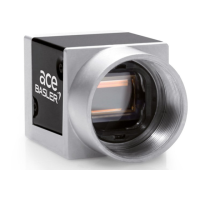Basic Operation & Standard Features
3-12 BASLER A102
f
DRAFT
3.2.6 Recommended Method for Controlling Exposure Start
If a camera user requires close control of exposure start, there are several general guidelines that
must be followed:
• The camera should be placed in continuous shot mode.
• The user must use an external trigger (ExTrig) signal to start exposure.
• The user must monitor the trigger ready (TrigRdy) signal.
• A rising edge of the ExTrig signal must only occur when the TrigRdy signal is high.
Assuming that these general guidelines are followed, the reaction of the camera to a rising
external trigger signal will be as shown in Figure 3-6:
• The start of exposure will typically occur between 0 µs and 63 µs after the rise of the ExTrig
signal.
• The integrate enabled (IntEn) signal will rise between 5 and 20 µs after the start of exposure.
• The actual length of exposure will be equal to the programmed exposure time.
• The IntEn signal will fall between 30 and 100 µs after the end of exposure.
3.2.7 Frame Buffering
As shown in Figure 3-6, after each image is captured, the camera begins reading out the captured
image data from the CCD sensor into a buffer in the camera. When the camera has determined
that a sufficient amount of image data has accumulated in the buffer, it will begin transmitting the
image data from the camera to the host PC.
This buffering technique avoids the need to exactly synchronize the clock used for sensor readout
with the clock used for data transmission over the IEEE 1394 bus. The camera will begin
transmitting data when it has determined that it can safely do so without over-running or under-
running the buffer. This buffering technique is also an important element in achieving the highest
possible frame rate with the best image quality.
The frame readout time is the amount of time it takes to read out a captured image from the
CMOS sensor into the image buffer.
The frame transmission time is the amount of time it takes to transmit the captured image from
the buffer in the camera to the host PC via the IEEE 1394 bus.
The transmission start delay is the amount of time between the point where the camera begins
reading out a captured image into the buffer to the point where it begins transmitting the data for
the captured image from the buffer to the host PC.
L
The camera can be programmed to begin exposure on a rising edge or on a falling
edge of an ExTrig signal. Also, two modes of exposure control are available: program-
mable and level controlled (see Section 3.2.5). For this illustration, we are assuming
that a rising edge trigger and the programmable exposure mode are used.

